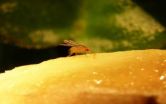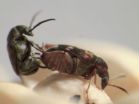(Press-News.org) TORONTO, ON – It is time to put the nature versus nurture debate to rest and embrace growing evidence that it is the interaction between biology and environment in early life that influences human development, according to a series of studies recently published in a special edition of the Proceedings of the National Academy of Sciences (PNAS).
"Biologists used to think that our differences are pre-programmed in our genes, while psychologists argued that babies are born with a blank slate and their experience writes on it to shape them into the adults they become. Instead, the important question to be asking is, 'How is our experience in early life getting embedded in our biology?'" says University of Toronto behavioural geneticist Marla Sokolowski. She is co-editor of the PNAS special edition titled "Biological Embedding of Early Social Adversity: From Fruit Flies to Kindergarteners" along with professors Tom Boyce (University of British Columbia) and Gene Robinson (University of Illinois).
Sokolowski, who is a University Professor in the Department of Ecology & Evolutionary Biology (EEB), the inaugural academic director of Uof T's Fraser Mustard Institute for Human Development and co-director of the Experience-based Brain and Biological Development Program (EBBD) at the Canadian Institute for Advanced Research (CIFAR) says that relatively little is known about the gene-environment interplay that underlies the impact of early life adversity on adult health and behaviour.
In one of the studies in the series, Sokolowski and her colleagues found that chronic food deprivation and lack of adequate nutrition in the early life of the fruit fly Drosophila melanogaster had significant impact on adult behaviour and quality of life. Fruit flies are especially useful for genetic studies because they share a surprising number of qualities with humans, are inexpensive to care for and reproduce rapidly, allowing for several generations to be studied in just a few months.
The researchers examined two types of fruit flies with variants in the foraging gene (for) known as rovers and sitters because of their different behaviours in the presence of food.
When well fed as larvae, rover adults exhibit darting exploration into open areas as they move about in search of food, while sitters show little of this behaviour. When nutritionally deprived as larvae, both rover and sitter adults exhibit darting exploration. Further, the sitters that faced nutritional adversity in early life displayed a reduction in their ability to reproduce. Rovers exhibited no effect on their reproductive fitness.
"The foraging gene makes an enzyme called PKG, which is found in the fly as well as in most other organisms, including humans. When faced with a nutritionally adverse environment while growing up, the levels of the enzyme dropped in flies," says Sokolowski. "This told us that the foraging gene listens to its environment." Transgenic manipulations of PKG levels altered darting exploration in well fed but not nutritionally deprived flies.
The research team included James Burns, a CIFAR junior fellow in Sokolowski's lab, U of T EEB professor Locke Rowe and EEB post-doctoral fellow Nicolas Svetec, as well as colleagues from the Universitiy of British Columbia and the Université Paris-Sud. The findings are reported in the paper "Chronic food deprivation in early life affects adult exploratory and fitness traits, in the October 16, 2012 issue of the Proceedings of the Nataional Academy of Science.
The papers in the volume are authored largely by CIFAR researchers, and comprise a multidisciplinary collection of research into fields from molecular genetics, evolutionary biology and neuroscience, to social and behavioural science, epidemiology and social policy – as well as the emerging field of epigenetics, which investigates deviations in a gene's ability to produce its products (e.g. RNA, protein) caused by mechanisms other than changes in an organism's underlying DNA sequence.
The collection of papers in the volume sets out an emerging new field of the developmental science of childhood adversity, and changes conventional understanding of the early years of human life.
"This is the first volume of collected research to provide a substantial and comprehensive picture of the interaction between experience and biology in the early years," says Sokolowski.
"Developmental neuroscience is extraordinarily intricate and complex, and so by approaching this question from multiple angles we're able to reveal a convergence on a number of themes and set a clearer direction for future research."
INFORMATION:
MEDIA CONTACTS:
Marla B. Sokolowski
Department of Ecology and Evolutionary Biology
University of Toronto
416-978-8325
marla.sokolowski@utoronto.ca
Sean Bettam
Communications, Faculty of Arts & Science
University of Toronto
416-946-7950
s.bettam@utoronto.ca
University of Toronto study demonstrates impact of adversity on early life development
Study part of growing body of knowledge surrounding gene-environment interplay
2012-10-25
ELSE PRESS RELEASES FROM THIS DATE:
For the Milky Way, it's snack time
2012-10-25
Using the Sloan Digital Sky Survey, researchers have discovered a band, or stream, of stars believed to be the remnant of an ancient star cluster slowly being ingested by the Milky Way, Earth's home galaxy.
"The Milky Way is constantly gobbling up small galaxies and star clusters," said Ana Bonaca, a Yale graduate student and lead author of a study forthcoming in Astrophysical Journal Letters. "The more powerful gravity of our Milky Way pulls these objects apart and their stars then become part of the Milky Way itself."
Researchers have previously found evidence of ...
Far from random, evolution follows a predictable genetic pattern, Princeton researchers find
2012-10-25
Evolution, often perceived as a series of random changes, might in fact be driven by a simple and repeated genetic solution to an environmental pressure that a broad range of specieshappen to share, according to new research.
Princeton University research published in the journal Science suggests that knowledge of a species' genes — and how certain external conditions affect the proteins encoded by those genes — could be used to determine a predictable evolutionary pattern driven by outside factors. Scientists could then pinpoint how the diversity of adaptations seen ...
Size does matter in sexual selection, at least among beetles
2012-10-25
A new collaborative project among researchers from Uppsala University in Sweden and the University of Cincinnati has, for the first time, demonstrated experimentally the evolutionary force behind the rapid evolution of male genitals, focusing on a species of seed beetle.
This mechanism is revealed in a study published today in the scientific journal Current Biology. The experiments leading to this paper involved a species of seed beetle known as Callosobruchus maculatus. Mating among these beetles involves several males engaging in copulation with individual females. ...
Results of the POSEIDON trial presented at TCT 2012
2012-10-25
MIAMI, FL – OCTOBER 25, 2012 – A hydration regimen tailored to the patient's fluid status was effective in reducing damage to kidneys in patients undergoing cardiac catheterization, according to a study presented at the 24th annual Transcatheter Cardiovascular Therapeutics (TCT) scientific symposium, sponsored by the Cardiovascular Research Foundation. TCT is the world's premier educational meeting specializing in interventional cardiovascular medicine.
Contrast-induced acute kidney injury (CI-AKI), or contrast-induced nephropathy, refers to kidney damage that may occur ...
1-year results of ADAPT-DES presented at TCT 2012
2012-10-25
MIAMI, FL – OCTOBER 25, 2012 – Patients who receive a drug-eluting stent (DES) and demonstrate low levels of platelet inhibition are more likely to have blood clots form on the stent and suffer a possible heart attack; conversely, patients with higher levels of platelet inhibition are at greater risk for bleeding complications. One-year results of the ADAPT-DES study were presented today at the 24th annual Transcatheter Cardiovascular Therapeutics (TCT) scientific symposium. Sponsored by the Cardiovascular Research Foundation, TCT is the world's premier educational meeting ...
Safety glass - cut to any shape
2012-10-25
If an object slams into the glass façade of a high-rise building, the glass must not shatter and fall down, because it could harm pedestrians below. In addition, the window panes must hold if a person were to fall against it from the inside. Architects and builders therefore must use something stronger than laminated safety glass on the façades of high rise buildings. The same applies to the windshields on cars. Safety glass prevents passengers in an accident from getting hurt by glass shards. And shop windows made of safety glass are expected to reliably safeguard the ...
"Spoon River Revisited" by Daniel J. Benor, MD: Messages From the Spirits - Halloween Launch From Wholistic Healing Publications
2012-10-25
One man's death is a tragedy; a million is a statistic. - Joseph Stalin
This book of prose poems is a captivating visit to the legendary town of Spoon River, viewed through the epitaphs of its residents. SPOON RIVER REVISITED is an insightful sequel to Edgar Lee Master's 1916 classic, Spoon River Anthology. The people who share their modern stories still struggle with challenges of growing up, making their way through life, and passing on.
Death has an undeserved, bad reputation! Within the understandings of western medicine, when the body stops working, that is ...
Timing is everything: Hormone use may reduce or increase Alzheimer's disease risk in women
2012-10-25
MINNEAPOLIS – A new study suggests that women who begin taking hormone therapy within five years of menopause may reduce their risk of developing Alzheimer's disease. The research is published in the October 24, 2012, online issue of Neurology®, the medical journal of the American Academy of Neurology.
"This has been an area of debate because observational studies have shown a reduced risk of Alzheimer's disease with hormone therapy use, while a randomized controlled trial showed an increased risk. Our results suggest that there may be a critical window near menopause ...
Nearly 80 million Americans won't need vitamin D supplements under new guidelines
2012-10-25
MAYWOOD, Ill. - Nearly 80 million Americans would no longer need to take vitamin D supplements under new Institute of Medicine guidelines, according to a study by Loyola University Chicago Stritch School of Medicine researchers.
Results were published Oct. 24, 2012 in the journal PLOS ONE.
The new guidelines advise that almost all people get sufficient vitamin D when their blood levels are at or above 20 nanograms per milliliter (ng/ml). Older guidelines said people needed vitamin D levels above 30 ng/ml.
Holly Kramer, MD, MPH and colleagues examined data from 15,099 ...
Genome analysis of pancreas tumors reveals new pathway
2012-10-25
HOUSTON -- (October 24, 2012) – , said a Baylor College of Medicine physician-scientist who was part of the local team that took part in the international effort. A report appears online in the journal Nature.
"We now know every gene involved in pancreatic cancer," said Dr. William Fisher, professor of surgery and director of the Elkins Pancreas Center at BCM. "This study ushers in a whole new era of taking care of patients with pancreatic cancer. We will look back on this as a turning point in understanding and treating this disease."
The study follows a five-year ...
LAST 30 PRESS RELEASES:
Scientists ID potential way to prevent brain injuries from triggering Alzheimer's
MASTER 2nd Open Call: Execution period kick-off
Algae for health in food and pharma
Advanced microrobots driven by acoustic and magnetic fields for biomedical applications
Chicago health information leader recognized for raising CPR readiness and blood pressure awareness
The Intimate Animal, a new book from Kinsey Institute Executive Director Dr. Justin Garcia
When blue-collar workers lose union protection, they try self-employment
New video dataset to advance AI for health care
MEA-based graph deviation network for early autism syndrome signatures in human forebrain organoids
New modeling approach sheds light on rare gut disease
Study documents potentially hazardous flame retardants in firefighter gear
Can certain bacteria regulate aging of the immune system and its related alterations?
AI model helps diagnose often undetected heart disease from simple EKG
There are fewer online trolls than people think
Cell membrane fluctuations produce electricity
Jeonbuk National University study shows positive parenting can protect adolescents against self-harm
Surface-engineered ZnO nanocrystals to tackle perfluoroalkyl substance contamination
This new understanding of T cell receptors may improve cancer immunotherapies
A new fossil face sheds light on early migrations of ancient human ancestor
A new immunotherapy approach could work for many types of cancer
A new way to diagnose deadly lung infections and save lives
40 percent of MRI signals do not correspond to actual brain activity
How brain-inspired algorithms could drive down AI energy costs
Gum disease may be linked to plaque buildup in arteries, higher risk of major CVD events
Contrails are a major driver of aviation’s climate impact
Structure of dopamine-releasing neurons relates to the type of circuits they form for smell-processing
Reducing social isolation protects the brain in later life
Keeping the heart healthy increases longevity even after cancer
Young adults commonly mix cannabis with nicotine and tobacco
Comprehensive review illuminates tau protein's dual nature in brain health, disease, and emerging psychiatric connections
[Press-News.org] University of Toronto study demonstrates impact of adversity on early life developmentStudy part of growing body of knowledge surrounding gene-environment interplay


